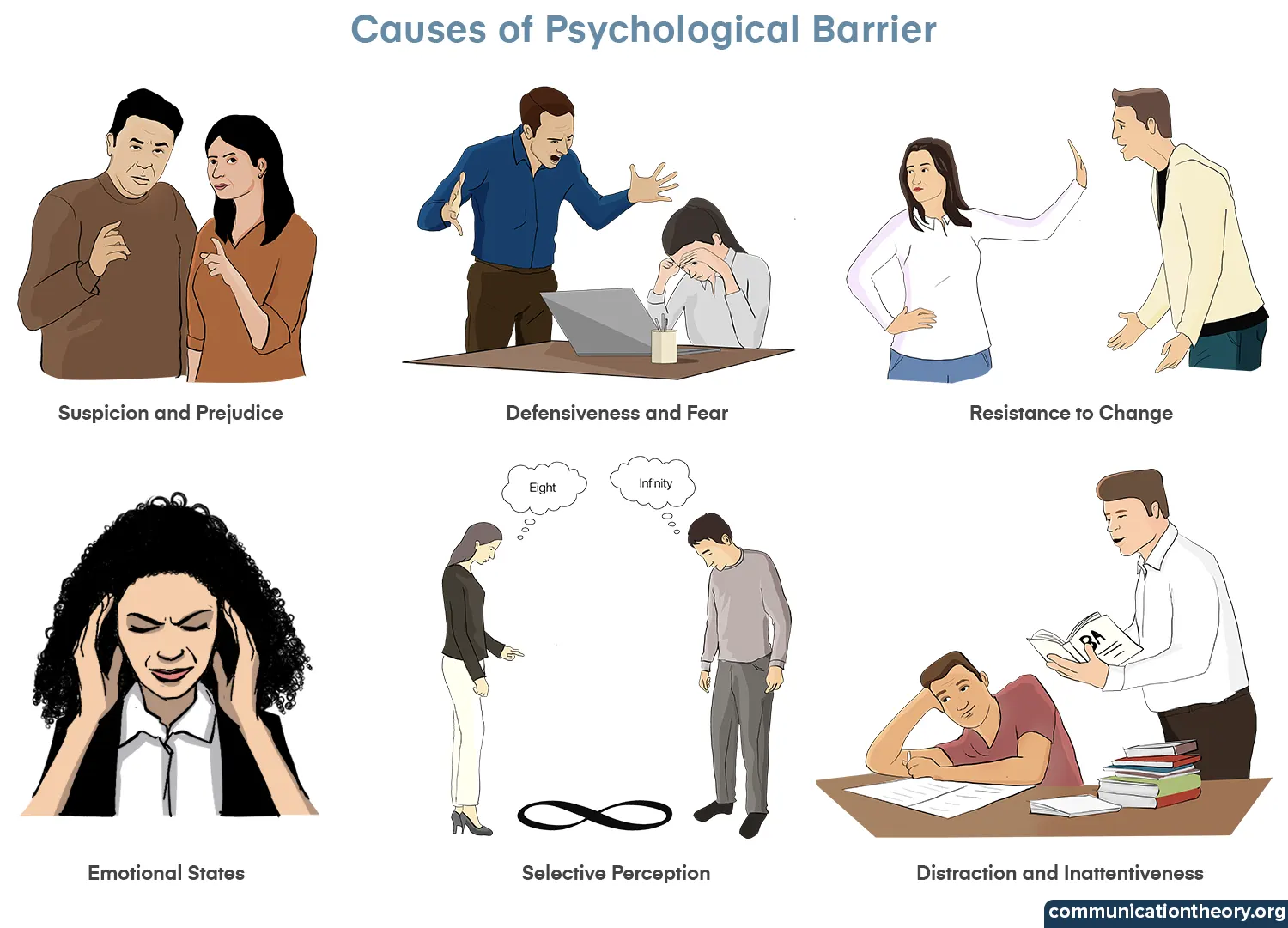Though communication is expected to be cyclic, there is an element called a barrier which refers to any hindrance affecting the whole process. Effective communication can be impeded by various kinds of barriers of communication such as linguistic barriers, psychological barriers, physical barriers, cultural barriers etc.

Source: pathdoc/Adobe Stock
What are the psychological barriers to communication?
Psychological barriers to communication refer to any psychological condition that affects the effectiveness of the communication. It refers to the various internal states people experience that inhibit communication.
Situations such as inattentiveness, lack of sleep, intoxication, stress, mental illnesses and many other factors may interfere with a good flow of communication. These are referred to as psychological barriers.
For example, Max performed his mathematics poorly because when Paul was teaching Max the equations, he could hardly take in what was being taught as he was tired and drowsy.
Psychological barriers cover many different psychological situations that hamper communication from taking place effectively. They are as follows.

1. Defensiveness and Fear
Defensiveness refers to the anxious state of an individual in challenging or avoiding criticism. This behavior of an individual is intended to defend or rather protect themselves. They become defensive to cover up their perceived flaws and weaknesses. They engage in behaviours such as giving snarky remarks, sarcasm, and aggression and these responses affect the effectiveness of the communication.
For example, when Sara tried correcting Samantha over a minute technical error, Samantha fired back at her asking her to mind her own business.
2. Frame of Reference
A ‘frame of reference’ is defined as the system of standards and values with an implicit or underlying and to some extent controlling action.
The experience one gains in life, particularly during childhood, and the cultural environment in which one grows up also contributes has a more significant influence on one’s frame of reference. A frame of reference is a crucial factor in limiting or distorting one’s perception of people, events, and circumstances. It paves the way for preconceived notions which alter one’s perception.
3. Suspicion
When there is a low trust factor between the sender and the receiver, the content that is relayed fails terribly. This kind of distrust arises when the sender or the receiver seems to be biased or hostile towards each other. Due to this suspicion, the communication is entirely misinterpreted or at times ignored.
For example, When a person whom you think to be fraudulent campaigns or endorses a good cause. We try to judge the campaign because of that personality.
4. Filtering
This is when the sender manipulates the message, they wish to convey so that the receiver views it favourably. This happens quite frequently in an organizational setup where the subordinates wish to communicate with the supervisor. They filter out their grievances and other essential information to avoid over-information and annoyance.
For example, when Michael went to discuss with his boss the issues happening amongst the employees, he gave a gist leaving out the details believing that he would be annoyed.
5. Distraction and Inattentiveness
Being inattentive or preoccupied with various factors such as exhaustion, stress, worries, drowsiness, intoxication etc. can make a person mentally unavailable to consciously observe the conversation. Also, he will be unaware of his surroundings.
For example, When an individual had a fight at home before attending a client meeting, his mind would be preoccupied with stressful thoughts and will not be able to concentrate on the proceedings of the meeting.
The intended message gets distorted, and the quality of the conversation suffers if the information is overloaded. This could also distract the listener.
For example, after going through a huge stack of project details, Sara could no longer take in any extra information as she felt exhausted and mentally overwhelmed.
6. Defective Retention
It is the ability of the individual to recall content that has been stacked up in the brain. This content is retained in the memory with the frequency at which the content is being recalled. Due to this, a part of the content sometimes is lost in time and the interpretation of the message highly depends on the fragments that are retained which in turn affects the decoding of the message.
For example, You were supposed to meet a client a month ago. But at the last moment, you are made to send one of your colleagues with all the details. But all that you can recall is his company’s name and the nature of his business. You are not able to recall his name.
7. Selective Perception
Any content that is communicated by default carries the perception of the sender. Though the receiver doesn’t always treat the content with the same perception, it is always good to define the opinions of the sender. Individuals live in their mindsets filled with their views and opinions and it becomes hard to penetrate that circle and convey content.
For example, An individual who raises an opinion against an issue which is neglected by the majority of the people around him, will not be taken in the right spirit. Even if he starts to explain himself, he will be branded with the opinion that he first stood for.
8. Presuppositions and Prejudgments
Sometimes humans tend to make assumptions, even before they participate in a conversation. In such instances, they believe their assumptions to be true and quickly judge and make decisions which will end up inappropriate in a situation.
The receiver does not try to understand all the aspects such as cultural, social and economic backgrounds. This may disrupt the true intent of the sender and therefore affect the effectiveness of the communication.
For example, Every time the sales head approaches Sara to have a discussion, she assumes that he is there to just make a complaint about her and so she puts out a defensive façade.
9. Emotional States
Different emotions can elicit different behaviours and responses in us. Consequently, the ability to comprehend a message as intended may get impacted by the nature and the intensity of emotions experienced. A few of the emotions that manipulate the content are anger, fear, anxiety, worry, confusion, mistrust, etc.
Intense emotions such as anger and jealousy can ruin the quality of a conversation as that prevents one from processing information rationally and with logic.
For example, If a person who has had an anxiety attack is suddenly pulled onto the stage for a speech, he would start stammering and might have a nervous breakdown as his mind will shut down thinking about what to speak.
10. Evaluation
It is human to evaluate the person in front of us and rush into judgements about their lifestyle, behaviour and profile. This is known as premature evaluation as we tend to have a presumption about the speaker and when he fails to be, so we end up drawing the wrong conclusions even before the message is conveyed. This also happens when the receiver is in a hurry and fills in the information all by himself without listening to the sender properly.
For example, You’re going to catch a train and your friend calls as usual to tip you off that he won’t be joining. And you in a hurry, pick the call and say yes, I had boarded the train you can start and you hang the call.
11. Whining or Complaining
Although venting out overwhelming emotions is helpful to take them out of the mind, there’s a wide gap between venting and whining. Venting is done mostly for the sake of relieving and finding clarity and it takes place a few times. However, whining happens very frequently and the person engaging in whining doesn’t really look for a solution, but rather just engages in the same conversational loop.
For example, Every time Sara meets Parker, he starts whining about how the food served in the cafeteria isn’t fresh and seems to have a stale odour. He does it almost every day; Sara can’t help herself but feel irritated about it.
12. Resistance to Change
Resistance to change refers to the reluctance one shows towards adaptation to a change. People who resist change have certain established opinions about specific matters or social customs and do not like to change them. This behavioral rigidity hinders communication altogether.
The change clubbed with the intensity is likely to bring in conflict, refusal and even confrontation. This behaviour causes the communication to become less effective and thus sets in as a barrier to communication.
Above mentioned categories are the major cause of the psychological barriers to communication. These act separately or as a combination to create a diversion in the communication process. Therefore, it must be overcome individually and gradually try to bring the level of its impact on the communication process.
Strategies for Effective Communication
- Active listening: The most crucial part of engaging in effective communication is to actively listen to the message being sent. Active listening refers to consciously trying to listen and comprehend what one has to say. This step can increase the potentiality of making communication effective.
- Non-verbal communication: Bodily gestures matter just as much as verbal statements during a conversation. It is integral to look out for the body gestures of other people so that the conversational transaction turns out smooth and efficient.
- Objective-oriented speech: Communicating with a purpose solves many problems and makes life much easier. Rather than beating around the bush, communicating to send the necessary message across saves much time and issues.
- Assertiveness: It can sometimes get hard to strike a balance between aggressive communication and passive communication. Assertive communication takes place when a person tries to put across their ideas and opinions without hurting the feelings of others.
- Empathy: It is a key skill to cultivate during communication. Empathy can help comprehend even some of the unsaid words of the other person. It also provides a sense of comfort and so it paves way for genuine communication to take place.
Strategies to handle psychological stress at the workplace
- Learning to manage time efficiently can help reduce stress.
- Although engaging in physical activity can seem time-consuming, research shows that exercising can help produce endorphin, which is very efficient in bringing down stress levels.
- Meditation is a great tool to organically calm down a racing mind. Taking a few minutes out to focus on the breathing pattern and internal sensations can work wonders.
- It is also highly essential to talk about the stressors with friends and family as it declutters the mind and if it doesn’t prove helpful, reaching a therapist might be beneficial.
Overcoming Psychological Barriers in Communication
- Make sure that the listener is physically and mentally available for communication.
- Acknowledging the thoughts and ideas of the speaker to make them feel validated.
- Expressing your unavailability to pay heed to the speaker and be accepting of the listener when such a concern is put forth.
- Communicating in a distraction-free location.
- Keeping the language and content simple and crisp.
- Ensuring that the listener understood the content and clarifying doubts.
- Be open-minded and avoid making assumptions about what the speaker intends to say.
Good learning experience
Thanks for knowledge it is good for learning
Thanks I’ve learned well, your explanations are good